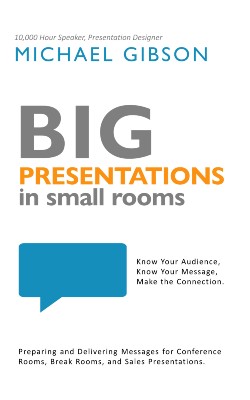Self-Focused Signs Create Negative Perceptions
Know your audience. Know your message. Make the connection. You got this. You are determined to communicate well and move the audience toward a better future.
Confidence allows you to move to the front and make your voice heard. But… we must be aware of our focus. And we must be aware of the perceptions created by our actions. Confidence is good. Arrogance is not. And the two concepts are often confused. A person might describe themselves as confident while observers might think they are arrogant. Others might be so worried about being labeled as arrogant that they end up appearing unconfident.

Augh! This can be a frustrating challenge.
Remember this: Perception is reality in the eyes of the beholder. And perceptions are based on observations. This leads to the questions:
When audience members observe you, what do they see? What do they hear? What perceptions are being created?
The ideal perception is that you care about them, and you are focused on them.
Let’s get practical and acknowledge three signs that a presenter is self-focused and not audience-focused.
Self-Focused Sign 1: Thinking the Resume is the Hook.
There are various opinions on this practice. Here is mine.
As a general rule, it is ineffective to lead with your resume. If your first words are self-focused, it could create the perception that you are self-focused and not audience-focused. It is better to have your first words be audience-focused. Seek to craft openings that are interesting and focused on the desires of the audience. It could be as simple as stating the issue and why it is important to your audience. Or it could be asking a question or making an observation that allows the audience to see that you care about their lives and the issues that affect their lives.

This does not mean that your resume should be excluded from your presentation. It means that there are better ways to accomplish this. When your content includes items with which you have experience, weave your resume in as you address that topic.
Saying something like, “When I worked for 20 years at Company X, I discovered that…” or
“While working on my doctorate at University of X, I carried out a survey that revealed that…”
You could also weave your resume into stories and illustrations that support your points.
This is a more natural and engaging way to share your expertise than an introduction that is easy to tune out or that might create a perception of arrogance.
Self-Focused Sign 2: Having an All-Purpose Story or Joke.
Most people have favorite stories and jokes. That is no problem. And those stories and jokes can become part of our identity among those we love. They might roll their eyes every time they sense a setup. “Uh-oh. Here it comes…”
And great stories are worth retelling… more than once. With no need for apology.
So, what is the problem?

The problem comes when a presenter does not seek out the best stories and jokes for each presentation. When a presenter is lazy and always reaches for the same story, illustration, or joke, it reveals the focus. It is self-focused in that it is seeking the easiest prep for the presenter rather than the best experience for the audience.
There will be times when a favorite story is also the best story for the occasion. Use it!
But be wary of the temptation to make it an all-purpose story. Hold yourself accountable. Ask for trusted coworkers to hold you accountable. Otherwise, the audience might tune out as soon as they hear you “telling that same old story…” and miss the point you seek to share.
If you ever feel that you are forcing a story to fit, skip it. Find a better one. If you have to work too hard to make a joke connect to the content, look for a better one. Or just make the point without a joke.
Focus on the audience. Tell stories and jokes that will best connect them to the content.
Self-Focused Sign 3: Wanting to be Liked more than Wanting to Help.
Another sign that you are more self-focused than audience-focused is that you want to be liked more than you want to help. Your desire to be popular is stronger than your desire to be truthful. This can be difficult to recognize. Some presenters have personalities that value relationships and have a strong desire to be accepted and liked.

The tension comes when there is a need to challenge the status quo—the way things are. People are naturally resistant to change—especially when that change requires adjustment and is front-loaded with extra work. People are naturally resistant to change when that change involves questioning or critiquing the past.
It can be tempting to sacrifice your integrity to be liked… but it shows that your values are ultimately self-focused. And the wise people in the room will see it. Perceptions will be created.
Self-Focused Sign 4: During Conflict, Being more Defensive than Curious
The final sign of being self-focused occurs during times of conflict. We want to be right. That is natural. We want our opinions and our guidance to be the best… and to be accepted as such. That, too, is common and understandable… and it can lead to problems.
It is problematic when others disagree. It can feel threatening when others feel that our opinions and our guidance are not the best. At times like this, we must be careful.

Perhaps you are familiar with The Golden Rule. It challenges us to treat other people the way we want to be treated. So how do we want to be treated? We want people to listen to us and be willing to consider our ideas.
When there is conflict, it is tempting to treat others in ways we would not want to be treated. It is easy to become defensive and unwilling to listen and consider. This is even more difficult when it happens at a presentation. We feel put on the spot. We might feel threatened. These emotions cause fight or flight symptoms to kick in… making it even harder to slow down, be respectful, and treat others the way you would want to be treated.
In times like this, keep in mind that perceptions are being created. People are paying attention to the way you respond. If you are self-focused, you will become defensive and unwilling to listen. If you are audience-focused, you will be curious and authentically interested in the thoughts and experiences of others.
This does not mean you are required to agree with them. It does mean that you are willing to listen and consider rather than rejecting and dismissing without consideration.
Pursue confident humility. Confident in your preparations. Humble in the realization that you are not all-knowing and all-wise. Confident in your identity. Even if you are wrong, you can change. You can grow. And people will respect your ability to do so. You are confident in your willingness to learn and consider various viewpoints. You are not defensive. You are audience-focused. You are curious.
Self-Focused Sign Change
As you continue to develop presentation skills, keep these four self-focused signs in mind.
Remember that your resume is not your hook. The best hooks focus on the audience! You can weave resume items throughout the presentation where they are most relevant.
Carefully curate your presentation to include only the best, most appropriate stories, jokes, and illustrations. You can re-use stories when they meet these criteria.
The purpose is to be helpful. If you try too hard to be liked, it will create a perception of weak character and self-focus. And people will not like you as much.
During conflict, exhibit confident humility. Be more curious than defensive. Treat others the way you want to be treated: listen and consider.
When your actions reflect an audience focus, you will create good perceptions that lead to increased respect and cooperation.
Do these things and you will be well on your way to making Big Presentations in Small Rooms!
Want to know more? Keep reading the blog!
Do you prefer to listen? Check out The Big Presentations Podcast!
Want to know even more? Order the book Big Presentations in Small Rooms!




